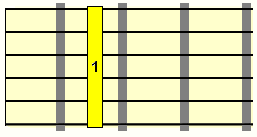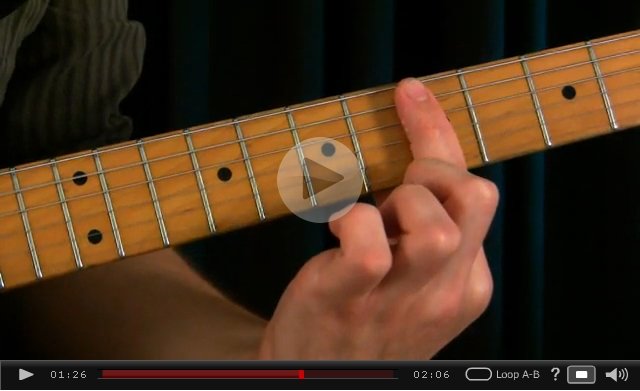Open Guitar Tuning - Audio Tuners and Tips
Open guitar tuning is a form of alternate tuning (from the standard E A D G B e) based around the notes of a major or minor chord.
When you're in open E tuning, for example, if you strum across all 6 strings open (without fretting), you will hear the chord E major.
Open tuning allows you to barre your finger across all 6 strings at any fret to get a full-voiced major or minor chord. Take a look at what you can do with this...
The advantage of open tuning is you can use the fact it's already tuned to a chord as a base and your other fingers are freed up to build on that chord with interesting extensions.
It's also used by bottle neck slide players, as you can apply the bottle neck across 5 or 6 strings to create that sliding chord effect.
Open guitar tuning can get you some rich sounds and different colors than we're used to with standard tuning. It's by no means a replacement for standard tuning, but something to have fun experimenting with.
Use the tuners below or try the flashier open guitar tuning tool here.
 Open
A Tuning
Open
A Tuning
 Open
C Tuning
Open
C Tuning
 Open
D Tuning
Open
D Tuning
 Open
E Tuning
Open
E Tuning
 Open
G Tuning
Open
G TuningOpen A guitar tuner - E A E A C# E
Click each string to hear and tune up.Playing all 6 strings unfretted in open A tuning sounds an A major chord.
| e |  |
| C# |  |
| A |  |
| E |  |
| A |  |
| E |  |
Tuning to Open A without a tuner
Sometimes you don't have a tuner (or this website!) handy. No problem. Assuming you're in standard tuning (or near enough), learn the following steps for future reference...- Keep the 6th and 5th strings as they are (E and A)
- Press the 5th string at the 7th fret and tune the 4th string to the same pitch (E)
- Press the 4th string at the 5th fret and tune the 3rd string to the same pitch (A)
- Press the 3rd string at the 4th fret and tune the 2nd string to the same pitch (C#)
- Press the 2nd string at the 3rd fret and tune the 1st string to the same pitch (e)
Open A minor tuning
There's just one note that determines whether a chord/tuning is major or minor (the major or minor 3rd interval). In this case, we flatten the C# string one half step to a minor 3rd - C
Click the string below to tune...
| C |  |
Open C guitar tuner - C G C G C E
Click each string to hear and tune up.Playing all 6 strings unfretted in open C tuning sounds a C major chord.
| e |  |
| C |  |
| G |  |
| C |  |
| G |  |
| C |  |
Tuning to Open C without a tuner
No tuner/access to the internet? No problem! The below steps will teach you how to get into open C from standard tuning...- Press the 6th string at the 3rd fret and tune the 5th string to the same pitch (G)
- Press the 5th string at the 5th fret and tune the 4th string to the same pitch (C)
- Press the 4th string at the 7th fret and tune the 3rd string to the same pitch (G)
- Press the 3rd string at the 5th fret and tune the 2nd string to the same pitch (C)
- Press the 2nd string at the 4th fret and tune the 1st string to the same pitch (e)
- Press the 5th string at the 5th fret and tune the 6th string down to the same note (C)
Open C minor tuning
Here, we simply flatten the e string to a minor 3rd - Eb (E flat)
Click the string below to tune...
| Eb |  |
Open D guitar tuner - D A D F# A D
Click each string to hear and tune up.Playing all 6 strings unfretted in open D tuning sounds a D major chord.
| d |  |
| A |  |
| F# |  |
| D |  |
| A |  |
| D |  |
Tuning to Open D without a tuner
Follow the below steps to tune to open D from standard tuning...- Tune down the 6th string until it matches the 4th string (D)
- Keep the 5th and 4th strings as they are (A and D)
- Press the 4th string at the 4th fret and tune the 3rd string to the same pitch (F#)
- Press the 3rd string at the 3rd fret and tune the 2nd string to the same pitch (A)
- Press the 2nd string at the 5th fret and tune the 1st string to the same pitch (d)
Open D minor tuning
There is just one note that determines whether a chord/tuning is major or minor (the 3rd tone of the major scale). In this case, we flatten the F# string to a minor 3rd - F
Click the string below to tune...
| F |  |
Open E guitar tuner - E B E G# B E
Click each string to hear and tune up.Playing all 6 strings unfretted in open E tuning sounds an E major chord.
| e |  |
| B |  |
| G# |  |
| E |  |
| B |  |
| E |  |
Tuning to Open E without a tuner
Follow these steps to tune to open E from standard tuning...- Press the 6th string at the 7th fret and tune the 5th string to the same pitch (B)
- Press the 5th string at the 5th fret and tune the 4th string to the same pitch (E)
- Press the 4th string at the 4th fret and tune the 3rd string to the same pitch (G#)
- Press the 3rd string at the 3rd fret and tune the 2nd string to the same pitch (B)
- Press the 2nd string at the 5th fret and tune the 1st string to the same pitch (e)
Open E minor tuning
There is just one note that determines whether a chord/tuning is major or minor (the 3rd tone of the major scale). In this case, we flatten the G# (G sharp) string to a minor 3rd - G
Click the string below to tune...
| G |  |
Open G guitar tuner - D G D G B D
Click each string to hear and tune up.Playing all 6 strings unfretted in open G tuning sounds a G major chord.
| d |  |
| B |  |
| G |  |
| D |  |
| G |  |
| D |  |
Tuning to Open G without a tuner
Follow these steps to tune to open G from standard tuning...- Press the 6th string at the 3rd fret and tune the 5th string to the same pitch (G)
- Tune down the 6th string until it matches the 4th string (D)
- Leave the 4th string as it is (D)
- Press the 4th string at the 5th fret and tune the 3rd string to the same pitch (G)
- Press the 3rd string at the 4th fret and tune the 2nd string to the same pitch (B)
- Press the 2nd string at the 3rd fret and tune the 1st string to the same pitch (d)
Open G minor tuning
There is just one note that determines whether a chord/tuning is major or minor (the 3rd tone of the major scale). In this case, we flatten the B string to a minor 3rd - Bb
Click the string below to tune...
| Bb |  |
Open tuning chords
Obviously, when you tune out of standard tuning (E A D G B e), any chord forms you knew in standard tuning will sound completely different. Open
tuning allows you simply to barre your index
finger across all 6 strings to create a "base" major or minor chord
(depending on whether you're in open major or open minor tuning).
Open
tuning allows you simply to barre your index
finger across all 6 strings to create a "base" major or minor chord
(depending on whether you're in open major or open minor tuning).You can then use your other fingers to add notes to that base chord.
The below open tuning chord table will show you what this base/barre chord will be at diffrent frets for different open tunings. Remember, the 12th fret is the octave of the open strings, so we get the same notes at the 12th fret as the open strings.
| Tuning Fret > | 1 | 2 | 3 | 4 | 5 | 6 | 7 | 8 | 9 | 10 | 11 | 12 |
| Open
A Major Open A Minor |
Bb Bbm |
B Bm |
C Cm |
C# C#m |
D Dm |
Eb Ebm |
E Em |
F Fm |
F# F#m |
G Gm |
Ab Abm |
A Am |
| Open
C Major Open C Minor |
C# C#m |
D Dm |
Eb Ebm |
E Em |
F Fm |
F# F#m |
G Gm |
Ab Abm |
A Am |
Bb Bbm |
B Bm |
C Cm |
| Open
D Major Open D Minor |
Eb Ebm |
E Em |
F Fm |
F# F#m |
G Gm |
Ab Abm |
A Am |
Bb Bbm |
B Bm |
C Cm |
C# C#m |
D Dm |
| Open
G Major Open G Minor |
Ab Abm |
A Am |
Bb Bbm |
B Bm |
C Cm |
C# C#m |
D Dm |
Eb Ebm |
E Em |
F Fm |
F# F#m |
G Gm |
| Open
E Major Open E Minor |
F Fm |
F# F#m |
G Gm |
Ab Abm |
A Am |
Bb Bbm |
B Bm |
C Cm |
C# C#m |
D Dm |
Eb Ebm |
E Em |
| Was this
helpful? Please support this site. I really appreciate it! |
Stay updated
and learn more Sign up to the newsletter for updates and grab your free Uncommon Chords book |
Share your thoughts...
Have any questions, thoughts or ideas about this lesson? Let us know using the comments form below.









